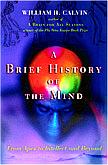|
COPY-AND-PASTE CITATION William H. Calvin, "Planning ballistic movements as a foundation for language." Keynote address to the FELDENKRAIS Educational Foundation of North America (22 August 2004). See also http://WilliamCalvin.com/2004/ballistic.htm |
William H.
Calvin |
|
Planning ballistic
movements as a foundation for language We know that our ancestors were
eating a lot of meat by about 1.8 million years ago. They had probably
figured out how to bring down big grazing animals, and with regularity.
But accurate throwing (as opposed to, say, the chimp’s fling of a
branch) is a difficult task for the brain. During “get set” one must
improvise an appropriate-to-the-target orchestration of a hundred
muscles and then execute the plan without feedback. The improvement during up-from-the-apes evolution doesn’t mean there was a bump developing on the skull that we might label “hand-arm planning center.” Nor is there a reason to expect it to rate a “for the exclusive use of” label. There is much evidence suggesting that oral-facial movement planning can overlap with that for hand-arm – and with that for language, both sensory and motor aspects. So we might expect to see “improve one function, improve some others in passing.” If some brain circuits are capable of running a process for making multistage coherent plans, and judging them for quality against your memory of what’s reasonable and safe, biased by your emotions, drives, hopes, and fears, we have a prime candidate for the transition from the simple two-word sentences (what two-year-olds speak) to the long complicated sentences that express structured thoughts. Just use the ballistic movement
planning circuits for other similar tasks in the spare time. And what
fits are the novel structured tasks of higher intellectual function,
such as syntax, contingent plans, polyphonic music, getting the joke,
and our search for how things all hang together (seen in crossword
puzzles and in doing science). Yes, some of them “pay their way”
subsequently, but the free lunch seems to be alive and well in the
brain, where novel secondary uses abound.
The Virtual Index for my books and articles, far better than my printed index in most cases: other authors' books (and who has quoted them): |
A Brief History of the Mind, 2004 Lingua ex Machina 2000 The Cerebral Code 1996 How Brains Think 1996 |






